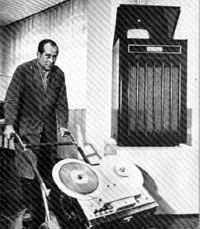|
In 1898, the Danish telephone engineer,
Valdemar Poulsen invented the first apparatus
for magnetic recording known as telegraphone.
Basically, in this apparatus a steel wire was wrapped in a
spiral form around a brass cylinder. An electromagnet rotates
around the cylinder following the wire in manner proportional
to the incoming sound signals. The level of magnetization of the recorded signals in the wire caused
a varying voltage in the electromagnet that again was proprotional
to the original incoming sound. This apparently simple process
of creating a permanent and recoverable magnetic image, proportional
to the incoming signal was the basis for all magnetic recording.
However, in spite of the simplicity of the Poulsen invention
it was still too primitive due to the lack of the valve for
the amplification of the signals, as well as a good recording
media .In the beginning of the twenties, Oberlim Smith used
iron filing as the magnetizing material applied over a flexible
backing.
of magnetization of the recorded signals in the wire caused
a varying voltage in the electromagnet that again was proprotional
to the original incoming sound. This apparently simple process
of creating a permanent and recoverable magnetic image, proportional
to the incoming signal was the basis for all magnetic recording.
However, in spite of the simplicity of the Poulsen invention
it was still too primitive due to the lack of the valve for
the amplification of the signals, as well as a good recording
media .In the beginning of the twenties, Oberlim Smith used
iron filing as the magnetizing material applied over a flexible
backing.
Based in this pioneering researches, in 1928,
E. Fritz Pfleumer in Germany, invented a process for the manufacturing
of the tape recording. For his working on the development
of a practical recording media known as the Blaterphone a
patent under the nš 500900 was issued to Pfleumer by
the German Patent Office.
However, since in the Pfleumer process the magentic material
was applied on a paper made backing, it was still too brittle
to support continuous operation. In this way in 1933 the German
company BASF started researches to obtein a more reliable
magnetic recording media.
In 1935, the German company AEG Telefunken launched in the
market the magnetophone, the foundation of the modern magnetic
tape recorder. This apparatus had an annular magnetic
head that through a bias current created the orientation of
the magnetic particles in a flexible tape.
However, at the beginning, due to several technological aspects
the magnetophone was not economically feasible. In this way,
it was only in 1946, just after the II World War, when A.
M. Poniatoff, in the USA, started the first commercial available
production line of magnetic tape recorders manufactured under
the trade name of AMPEX.
Since then many innovation were introduced in the magnetic
recording. Originally the tape recorder used reels with the
magnetic tape entailed the drawback of recquiring some skill
for handling. In 1965, Philips in Holland launched in the
world market the music cassettes, in which the tape is automatically
wound in both direction as well it can simply be slid into
the tape recorder. Such innovation spread worldwide quickly
and in this way it became as much popular as the gramophone.
Around 1970, the quality of the recorded sound on tape was
improved even more with the birth of the noise supressors
circuits such as the Dolby and DBX as well as the development
of new binders and magnetic materials such as the Chromiun
Oxide and advanced types of Iron Oxides, allowing great dynamic
range with the lowest signal distorsion.
|